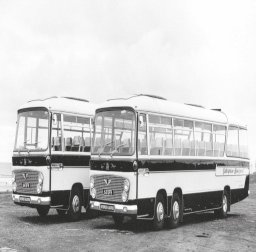articles/Profiles/mayhem-page3
From Mayhem To Mamiyaa - part 3 of 1 2 3
Published 01/12/1999

In the Director's office at Woolley's there were a number of large, framed photographs of mountains, which at first seemed out of place on the premises of a wholesale manufacturing chemist - but I later learned that members of the family had been amongst the first to climb Mount Woolley in Canada, bestowing upon it the family name in the process. One of my many personal customers at Woolley's was a nineteen year old William Roache who called to collect goods for his father's retail chemist shop. Another customer was an Art Director from Granada Studios and I was invited to the studios and saw rehearsals and shooting of Coronation Street in the early days when it was in black and white. What struck be most about all this was that there were no whites on the set at all. Table cloths were yellow, shirts were yellow - everything which might have been white was yellow, this being the only way in which the contrast could be controlled. Tables and chairs were raised up from the floor some four or five inches - the cameras of the time were unable cope with low angle shots. I travelled to Manchester daily by train - a journey not without interest.
'Coronation Street' cast members were often on the same train and spent the time learning their scripts. Violet Carson (Ena Sharples to devotees) was amongst them - I was later to take her picture for Spirella at her home in Blackpool. Landlord of the Rover's Return Jack Walker (Arthur Leslie) and the first to die of the Ena Sharples trio, Martha Longhurst (Lynne Carol) also travelled on the same train.
These were interesting and enjoyable days.
When I had been at Woolley's for about eighteen months I learned that BDH was about to take over the firm and I thought it time to make myself scarce. I had heard of a photographic post at Shopfitters, Oswaldtwistle (Later Lancashire Shopfitters) and I went after it. Despite the fact that I was the only applicant, the interview was very stiff and I got the job principally because I had a good working knowledge of 3D stereo photography, owning my own stereo camera.
Few people could make such a claim in those day. The object of all this being to let the public at large know who I was and where I was. Some of these pictures were also placed in the lobby and on the staircase to encourage potential customers to wander inwards and upwards. My first wedding pictures were taken using a 5 x 4 MPP press camera - yes, that is what we used in those days! - and later with a 5 x 4 Linhoff. I had 24 double dark slides and a massive bulb flash gun. The whole collection gave me enough exercise to preclude the need for any visits to a gymnasium! Portraits were done on a Soho quarter plate camera or on a Rolleiflex TLR. Grain was the great enemy. There were no fine grain emulsions and there were no fine grain developers - hence the large formats. This is probably why I am not a fan of the current fashion for 'grainy' style pictures. I took the pictures - and developed and printed them all myself - and Greta took on the office work.
She was a very friendly type and got business for me from work. I kept on friendly terms with the other photographers of the day in Blackpool and later we formed a group which met in winter at local hotels to have working suppers. These were mostly social meetings, but occasionally we would invite a local vicar or taxi-driver, or any one else who impinged on our work, to talk over any problems.
During the same period, partly to make myself known to a wider public, and partly to help out with income, I became a part time tutor in the photographic department at Blackpool Technical College. I was the only member of the staff there to have experience as a working professional photographer.
Please Note:
There is more than one page for this Article.
You are currently on page 3
1st Published 01/12/1999
last update 09/12/2022 14:56:34
More Profiles Articles
There are 0 days to get ready for The Society of Photographers Convention and Trade Show at The Novotel London West, Hammersmith ...
which starts on Wednesday 15th January 2025





